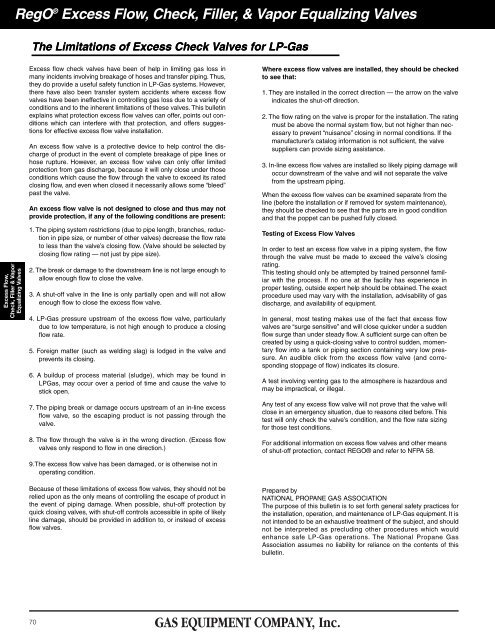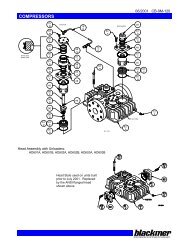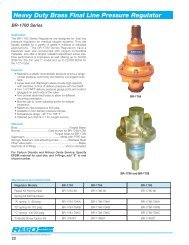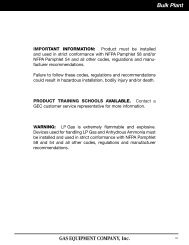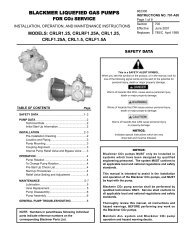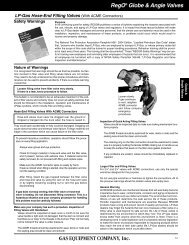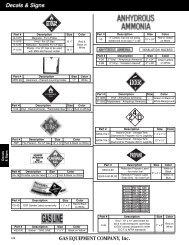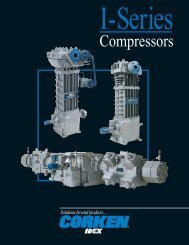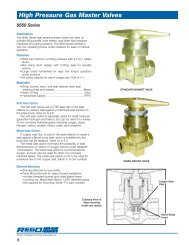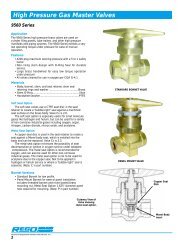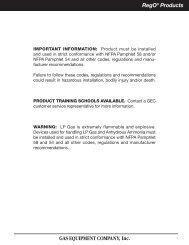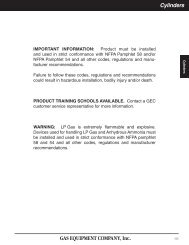Excess Flow, Check, Filler & Vapor Equalizing Valves
Excess Flow, Check, Filler & Vapor Equalizing Valves
Excess Flow, Check, Filler & Vapor Equalizing Valves
Create successful ePaper yourself
Turn your PDF publications into a flip-book with our unique Google optimized e-Paper software.
RegO ® <strong>Excess</strong> <strong>Flow</strong>, <strong>Check</strong>, <strong>Filler</strong>, & <strong>Vapor</strong> <strong>Equalizing</strong> <strong>Valves</strong>The Limitations of <strong>Excess</strong> <strong>Check</strong> <strong>Valves</strong> for LP-Gas<strong>Excess</strong> <strong>Flow</strong>,<strong>Check</strong>, <strong>Filler</strong> & <strong>Vapor</strong><strong>Equalizing</strong> <strong>Valves</strong><strong>Excess</strong> flow check valves have been of help in limiting gas loss inmany incidents involving breakage of hoses and transfer piping. Thus,they do provide a useful safety function in LP-Gas systems. However,there have also been transfer system accidents where excess flowvalves have been ineffective in controlling gas loss due to a variety ofconditions and to the inherent limitations of these valves. This bulletinexplains what protection excess flow valves can offer, points out conditionswhich can interfere with that protection, and offers suggestionsfor effective excess flow valve installation.An excess flow valve is a protective device to help control the dischargeof product in the event of complete breakage of pipe lines orhose rupture. However, an excess flow valve can only offer limitedprotection from gas discharge, because it will only close under thoseconditions which cause the flow through the valve to exceed its ratedclosing flow, and even when closed it necessarily allows some “bleed”past the valve.An excess flow valve is not designed to close and thus may notprovide protection, if any of the following conditions are present:1. The piping system restrictions (due to pipe length, branches, reductionin pipe size, or number of other valves) decrease the flow rateto less than the valve’s closing flow. (Valve should be selected byclosing flow rating — not just by pipe size).2. The break or damage to the downstream line is not large enough toallow enough flow to close the valve.3. A shut-off valve in the line is only partially open and will not allowenough flow to close the excess flow valve.4. LP-Gas pressure upstream of the excess flow valve, particularlydue to low temperature, is not high enough to produce a closingflow rate.5. Foreign matter (such as welding slag) is lodged in the valve andprevents its closing.6. A buildup of process material (sludge), which may be found inLPGas, may occur over a period of time and cause the valve tostick open.Where excess flow valves are installed, they should be checkedto see that:1. They are installed in the correct direction — the arrow on the valveindicates the shut-off direction.2. The flow rating on the valve is proper for the installation. The ratingmust be above the normal system flow, but not higher than necessaryto prevent “nuisance” closing in normal conditions. If themanufacturer’s catalog information is not sufficient, the valvesuppliers can provide sizing assistance.3. In-line excess flow valves are installed so likely piping damage willoccur downstream of the valve and will not separate the valvefrom the upstream piping.When the excess flow valves can be examined separate from theline (before the installation or if removed for system maintenance),they should be checked to see that the parts are in good conditionand that the poppet can be pushed fully closed.Testing of <strong>Excess</strong> <strong>Flow</strong> <strong>Valves</strong>In order to test an excess flow valve in a piping system, the flowthrough the valve must be made to exceed the valve’s closingrating.This testing should only be attempted by trained personnel familiarwith the process. If no one at the facility has experience inproper testing, outside expert help should be obtained. The exactprocedure used may vary with the installation, advisability of gasdischarge, and availability of equipment.In general, most testing makes use of the fact that excess flowvalves are “surge sensitive” and will close quicker under a suddenflow surge than under steady flow. A sufficient surge can often becreated by using a quick-closing valve to control sudden, momentaryflow into a tank or piping section containing very low pressure.An audible click from the excess flow valve (and correspondingstoppage of flow) indicates its closure.A test involving venting gas to the atmosphere is hazardous andmay be impractical, or illegal.7. The piping break or damage occurs upstream of an in-line excessflow valve, so the escaping product is not passing through thevalve.8. The flow through the valve is in the wrong direction. (<strong>Excess</strong> flowvalves only respond to flow in one direction.)Any test of any excess flow valve will not prove that the valve willclose in an emergency situation, due to reasons cited before. Thistest will only check the valve’s condition, and the flow rate sizingfor those test conditions.For additional information on excess flow valves and other meansof shut-off protection, contact REGO® and refer to NFPA 58.9.The excess flow valve has been damaged, or is otherwise not inoperating condition.Because of these limitations of excess flow valves, they should not berelied upon as the only means of controlling the escape of product inthe event of piping damage. When possible, shut-off protection byquick closing valves, with shut-off controls accessible in spite of likelyline damage, should be provided in addition to, or instead of excessflow valves.Prepared byNATIONAL PROPANE GAS ASSOCIATIONThe purpose of this bulletin is to set forth general safety practices forthe installation, operation, and maintenance of LP-Gas equipment. It isnot intended to be an exhaustive treatment of the subject, and shouldnot be interpreted as precluding other procedures which wouldenhance safe LP-Gas operations. The National Propane GasAssociation assumes no liability for reliance on the contents of thisbulletin.70


